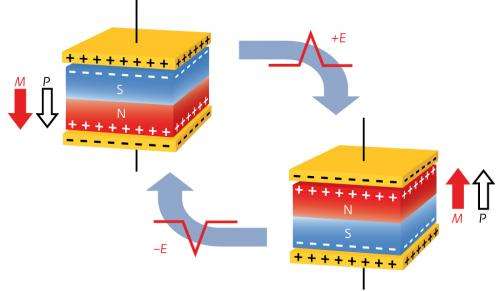Reversal of magnetic moment by an electrical voltage in a single material could lead to new low-power electronic devices

Researchers at the Advanced Science Institute at Wako, Japan, have discovered a material whose magnetic orientation can be fully switched by electric voltages. Such switchable materials have applications for magnetic data storage or novel electronic devices that use the electron's magnetic properties. As Yusuke Tokunaga from the research team explains, "Reversal of magnetization by a voltage enables ultra-low power consumption electronic devices because applying a voltage and not an electrical current means that such devices are free from Joule heating loss."
Many materials show magnetism and many also show electric polarization, where permanent electric dipole moments persist even when the external electrical voltage is turned off. However, only a few materials—known as multiferroics—show both these so-called ferroic properties simultaneously. In many multiferroics, these two properties are coupled so that the electric polarization can be changed around by switching the magnetic field. But from a practical perspective, for example in data storage, the opposite scenario of switching magnetism with an electrical voltage is more interesting. Until now, this type of coupling has not been observed in a material.
An example of the first type of coupling is GdFeO3. This material has been shown previously to be multiferroic by the same research group, but changes in the electric field had only minor influences on magnetism. The related compound DyFeO3, on the other hand, is known to have a strong coupling between magnetism and electrical fields in principle, but it is not a multiferroic as it requires external magnetic fields to show this coupling. The researchers' aim was to try and unify these properties by synthesizing crystals of (Dy,Gd)FeO3, and indeed, some of the resulting compounds—including compounds where Tb was used instead of Gd—show the desired properties. Not only are they multiferroic, but for the first time they also show a complete reversal of magnetization by an electric field.
So far, the effect is limited to temperatures barely a few degrees above absolute zero. Extending the work to compounds that show this behavior at higher temperatures is an important next step, confirms Tokunaga. "For the practical application toward ultra-low power consumption devices we need to find new multiferroics that can operate at higher temperatures." With the insights gained on how to achieve magnetic switching, he believes this is highly possible.
More information: Tokunaga, Y., Taguchi, Y., Arima, T.-H. & Tokura, Y. Electric-field-induced generation and reversal of ferromagnetic moment in ferrites. Nature Physics advance online publication 19 August 2012 doi:10.1038/nphys2405.
Journal information: Nature Physics
Provided by RIKEN




















